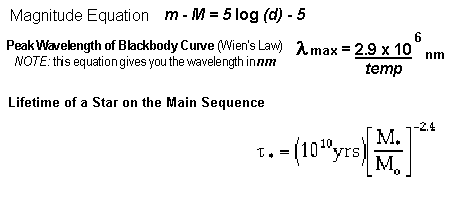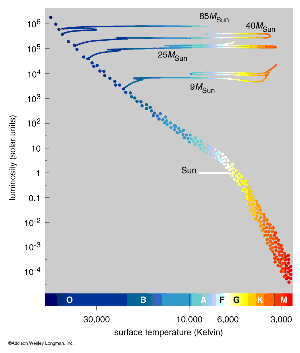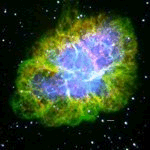
Exam 2: Stars (take home test) | ||
| Name ___________________________________ Star Name _______________________________ |
Score _______________ Date: ________________ | |

| Star Name | Bayer Designation |
Surface Temperature | Spectral Type |
Luminosity Class |
Apparent Magnitude |
Absolute Magnitude |
Distance (Parsecs) |
|---|---|---|---|---|---|---|---|
 (9
pts)Reproduced here is Fig. 14.15 of your text.
(9
pts)Reproduced here is Fig. 14.15 of your text.
| BSC No. | Name (ID) | Apparent Magnitude |
Parallax (arcsec) | Spectral Type Luminosity Class |
Absolute magnitude |
|---|---|---|---|---|---|
| Sun (Sol) | -26.00 | G2 V | 4.75 | ||
| 2491 | Sirius | -1.46 | 0.375 | A1 V | 1.41 |
| 2326 | Canopus | -0.72 | 0.028 | F0 II | -3.48 |
| 5340 | Arcturus | -0.04 | 0.090 | K1.5 III | -0.27 |
| 5459 | Rigil Kentaurus | -0.01 | 0.751 | G2 V | 4.37 |
| 7001 | Vega | 0.03 | 0.123 | A0 V | 0.48 |
| 1708 | Capella | 0.08 | 0.073 | G5 III + G0 III | -0.60 |
| 1713 | Rigel | 0.12 | 0.013 | B8 I | -4.31 |
| 2943 | Procyon | 0.38 | 0.288 | F5 IV | 2.68 |
| 0472 | Achernar | 0.46 | 0.026 | B3 V | -2.47 |
| 2061 | Betelgeuse | 0.50 | 0.005 | M1 I | -6.01 |
| 5267 | Hadar | 0.61 | 0.009 | B1 III | -4.62 |
| 7557 | Altair | 0.77 | 0.198 | A7 V | 2.25 |
| 1457 | Aldebaran | 0.85 | 0.048 | K5 III | -0.74 |
| 6134 | Antares | 0.96 | 0.024 | M1.5 I + B4 V | -2.14 |
(1 pts)
Which of the spectral type B stars have finished fusing hydrogen in
their cores?
(1
pts) Among the main-sequence stars listed, which one is the most
massive?
(1
pts) Among the main-sequence stars listed, which one has the longest
lifetime?
(1
pts) Which star is the closest?
(1 pts) Which star is the farthest?
 |
 |
 |
|---|---|---|
| X-Ray | Optical | Radio |